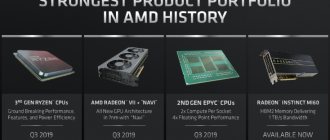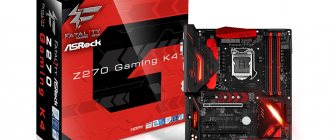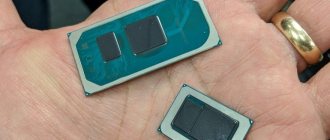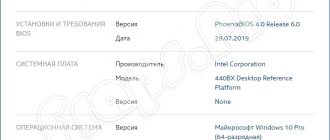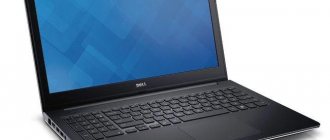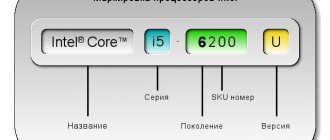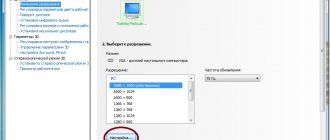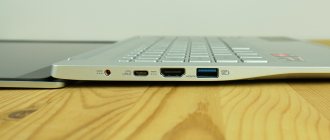Part 1 → Part 2 → Part 3 → Part 4 Intel's latest lineup of desktop processors mostly includes changes aimed at performance enthusiasts. Intel has expanded consumer processors to eight cores, increased frequencies, improved thermal management, and updated hardware to better protect against Specter and Meltdown vulnerabilities. The only negative: you will have to fork out money and buy a powerful cooler. This time, prices and energy consumption have reached new limits.
Coffee Lake Update
In the publication of Intel's announcement, we dwelt in detail on three new processors. Here's a quick reminder about the newest chip on the market. There are currently three processors available: the 8-core Core i9-9900K, which is capable of running at 5.0 GHz out of the box, the 8-core Core i7-9700K, which is slightly cheaper, and the 6-core Core i5-9600K, which according to the specifications, it deserves the title of “market absorber”.
The new flagship is the Core i9-9900K, the world's first mainstream desktop processor bearing the Core i9 name. This is an eight-core processor with sixteen threads, the first in a new line of Intel products. It offers a base frequency of 3.6 GHz and a maximum turbo frequency of 5.0 GHz, which actually turns out to be a dual-core turbo (we'll demonstrate this fact below). In addition, the processor is ready for overclocking, which will allow users to overclock the frequency provided there is sufficient cooling. And while the memory controller is still officially rated for DDR4-2666, faster memory will work on virtually every chip. Plus, the Core i9-9900K has a fully-enabled cache with 2 MB per core, which gives a total of 16 MB of cache. There is built-in graphics, the same UHD 630 as in the previous generation. All this comes with a retail price of $488, cooler not included.
The Core i7 now turns out to be the “middle” of the line, the Core i7-9700K, in turn, looks magical. Intel has done away with hyper-threading in this processor, providing only eight threads on eight cores, but with a base frequency of 3.6 GHz and a turbo frequency of 4.9 GHz. For the Core i7-9700K, Intel has reduced the L3 cache to 1.5MB per core, which may impact some software, but the processor is ready for overclocking and has DDR4-2666 support, just like the Core i9. The suggested retail price of $374 is a little easier to accept if the user can be sure that two threads will never share the resources of one core. It will be interesting to compare this chip with the latest generation Core i7-8700K processor. The Core i7-8700K has two fewer cores but uses hyperthreading.
The Core i5-9600K appears to be a "training overclocker" chip, and the price is still $262, which is a few dollars more than the Core i5-8600K in exchange for the extra clock and all the extra features listed later in this article. The base frequency is 3.7 GHz and the turbo frequency is 4.6 GHz, there is support for DDR4-2666 and UHD 630 graphics.
All three parts are the first representatives of the Intel 9th Generation Core product line, and “under the hood” they hide an update to the Coffee Lake architecture, which was used in the 8th generation Core products. They are built on Intel's 14++ manufacturing node, the latest node that now sets the standard for high frequency and performance. Key aspects of the new three-processor lineup, including their overall overclockability, stem from internal changes made by Intel.
Turbo each core
We were able to obtain per-Core Turbo values for each processor in the new line. Intel still classifies this information as "proprietary" and therefore does not distribute it. However, Intel partners were happy to provide us with the information, given the fact that it is encoded in the system BIOS anyway.
The big jump here is the 5.0 GHz turbo. In our review of the Core i7-8086K, where Intel had the opportunity to push the chip as its first 5.0GHz product, the fact that 5.0GHz was on a single core was actually a disadvantage - regardless The way we tested the processor, there was enough load to run on more than one core, and the user never actually sees the actual 5.0GHz. We only once managed to see the core momentarily “flare up” at the promised frequency while waiting at idle. The Core i9-9900K now has two cores clocked at 5.0, which likely means we'll still see that high clock in our single-threaded testing.
More coffee, less caffeine: Hyper-Threading and L3 Cache
While it would seem that Intel has decided to avoid hyper-threading on its new processors, the only Core processors that will receive simultaneous multi-threading will be the Core i9 and possibly Pentium components.
This partly helps make the product line clearer, with cheaper chips not stepping on the toes of more expensive ones (for example, it's unlikely that a quad-core processor with simultaneous multi-threading can outperform a 6-core processor without). The other side is one of the recently discovered “side channel attack” vulnerabilities that occurs when hyper-threading works. By disabling simultaneous multithreading on its line of chips, Intel mitigated this security issue. Now we can ensure that every thread on this chip does not compete for core resources. One of the most interesting aspects of the new 9th generation products lies in the division of the L3 cache “by core” for different models. In previous generations of processors, the Core i7 had 2 MB of L3 cache per core, the Core i5 had 1.5 MB of L3 cache per core, and the Core i3 had a split between some with 2 MB and some with 1.5 MB. This time, Intel puts full cache only on the top-end Core i9 components, and reduces the Core i7 cache to 1.5 MB L3 per core. This will have some impact on performance, which will be interesting to test when we get the processors.
Integrated Graphics
One of the topics that Intel hasn't paid serious attention to for several generations (in fact, since the days of Broadwell) is integrated graphics.
All chips introduced in the 9th generation family will continue to have the same GT2 configuration as the 8th generation, including the new Core i9 processors. Officially, they fall under the 8+ 2 designation. Intel still believes that having integrated graphics on these high-performance, overclockable processors is a valuable addition to the platform. The only downside is the performance and it will remain low for the near future. The graphics will continue to be designated UHD Graphics 630 and use the same drivers as the 8th generation family.
Coffee Lake Refresh: lessons from GPU manufacturers
The Intel 9th Generation Core processor family is built on the Coffee Lake platform, and since the processors do not have any microarchitectural changes, they are an update to the 8th generation products, but with a slight change in the lineup. For those who followed the development of Intel processors, Coffee Lake was a remake of Kaby Lake (in turn, an update of Skylake). So we're in the update update update update. Which is essentially the same microarchitecture from 2020 being produced again in 2020 (and will continue to be produced).
Intel has promised that its 10nm manufacturing process will continue to develop through 2020, and has already announced that it will introduce Ice Lake for 10nm servers in 2020, following another 14nm release with Cooper Lake in 2020. From a consumer perspective, the status remains uncertain - in any case, the next generation of consumer processors should be a proper microarchitecture upgrade, regardless of process node nanometers.
I will have 8 cores for many, many years!
No matter how we look at the line of “consumer” processors, technically, for a number of years, the top of the stack has always been 8-core Intel processors.
The Core i7-5960X was released in August 2014 and featured eight Haswell cores on the HEDT platform with quad-channel DDR4-2133 memory and 44 140W PCIe slots. Then, according to Intel's 22 nm process technology, the matrix size was about 355.52 mm2. When Intel launched the first Coffee Lake processors, the 6+2 design of the i7-8700K was around ~151mm2, which is 26mm2 larger than the 4+2 design of the i7-7700K (~125mm2). At the time, it was a jump from Intel's official 14+ to the 14++ production node, which made the processors slightly larger due to fin height.
But if we accept 26 mm2 as the limit for the increase in die size when adding a pair of cores, we can predict that the size of the 8+2 Core i9-9900K should be about 177 mm2, or 17% larger. At 177mm2, including integrated graphics, it will be half the size of the Core i7-5960X, albeit with half the number of memory controllers and PCIe lanes. But, in any case, this is a significant reduction.
One might assume that a 17% increase in die area could directly translate into a 17% increase in price. In this case, a 17 percent increase in the price of the Core i7-8700K would bring us to a price of $420, while the official price is $488 for the K-equivalent processor. Given Intel's pricing policy (one chip can sell for half the price of another), it's hard to say how much that $488 increases the product's profitability for the company.
If we look at the top-tier chip sizes, die size has steadily shrunk over the decade of quad-core processors, starting with the Nehalem quad core at over 260mm2, all the way up to Kaby Lake at 125mm2. It is currently increasing steadily as more and more cores are added. It's scary to think that Intel would happily spend 260+ mm2 on mainstream silicon today, on its latest manufacturing process.
Advanced Ice Lake series processors
Contrary to the expectations of many, Intel did not disclose either the models of the new line of processors or their characteristics. However, the American manufacturer named the key features of the new products, focusing in detail on the laptop versions of the processors. The main innovations in the Ice Lake series are a new microarchitecture called Sunny Cove, as well as a 10-nanometer process technology - the processors will be more energy efficient and more productive than their predecessors (who would have thought). Intel was going to master this production process back in 2020, but was only able to implement its plans now.
The first representatives of the new line will be the Ice Lake-U and Ice Lake-Y models designed for laptops. The former received increased levels of first and second level cache memory compared to their predecessors, support for LPDDR4X memory (most likely with a frequency of 3,200 MHz), Wi-Fi 6 (802.11ax) and Thunderbolt 3. Among other things, the new processors now have graphics 11th generation, which is capable of decoding 4K video, processing video recordings with a resolution of up to 8K, and also working with HDR and Adaptive Sync technologies. Particular attention was paid to the autonomy of laptops running on the new processors: according to official statements, devices with the new chipsets will be able to work without recharging for up to 25 hours. Ice Lake-U models are single-chip systems (they contain a central and graphic processors on one chip, as well as many auxiliary components) - in other words, they take up relatively little space. Thanks to this, manufacturers of portable devices will be able to equip their gadgets with more capacious batteries.
The first laptops based on Ice Lake-U and Ice Lake-Y processors are expected to appear by the end of 2020.
Processor Intel Core i5-10600
The range of tenth generation Intel Core i5 processors cannot be called meager. It has Core i5-10400, Core i5-10500 and Core i5-10600 (each stone also has additional modifications with an unlocked multiplier, missing graphics core, etc.). All of these devices are 6-core (with support for Hyper-Threading technology, that is, these solutions have 12 computing threads), they differ from each other only in clock frequencies.
In Ghost Recon Wildlands, the Intel Core i5-10600 load does not exceed 45%.
The top Core i5 of the Comet Lake family is the unlocked 10600K, and the most optimal and balanced (in terms of power/price) is the 10400F. So why, you ask, do you need a Core i5-10600?
It is very difficult to give a definite answer to this question, because finding an operation that the four hundredth could not cope with is not so easy. Although the Core i5-10600 still has one advantage - a high clock speed. It helps to outperform its younger brothers in games by a couple of percent (but a little later we will convince you that such a powerful CPU is not required for gaming).
Technical features
Intel Core i5-10600 is a 6-core processor with 12 computational threads and a locked multiplier (you will hardly be able to overclock it to serious values). This CPU has integrated Intel UHD Graphics 630 (in our opinion, an absolutely useless bonus), which can handle displaying three-dimensional images on one or more displays, and is also suitable for scrolling videos.
This 14 nm processor is compatible with Socket LGA 1200 and dual-channel DDR4-2666 RAM (be sure to install something higher frequency into the system). Cache size is 12 MB.
| Core i5-10600K | Core i5-10600 | Core i5-9600KF | Ryzen 5 3600X | |
| Technical process | 14 nm | 14 nm | 14 nm | 7 nm |
| Socket | LGA 1200 | LGA 1200 | LGA 1151 | AM4 |
| Cores/threads | 6/12 | 6/12 | 6/6 | 6/12 |
| Clock frequency | 4100/4800 MHz | 3300/4800 MHz | 3700/4600 MHz | 3800/4400 MHz |
| L3 cache | 12 MB | 12 MB | 9 MB | 32 MB |
| TDP | 125 W | 65 W | 95 W | 95 W |
| Memory support | DDR4-2666, 2 channels | DDR4-2666, 2 channels | DDR4-2666, 2 channels | DDR4-3200, 2 channels |
| PCI-E version | 3.0 | 3.0 | 3.0 | 4.0 |
| Unlocked multiplier | Yes | No | Yes | Yes |
| Integrated Graphics | Intel UHD Graphics 630 | Intel UHD Graphics 630 | No | No |
| Price | 21,000 rubles | 17,000 rubles | 14,000 rubles | 15500 rubles |
All six physical cores of the Core i5-10600 nominally operate at 3300 MHz; in automatic acceleration mode, the frequency of one of them increases to 4800 MHz. These are good numbers for a locked 6-core processor, and they help the stone demonstrate high performance in multimedia applications (including games).
If you decide to purchase the Intel Core i5-10600 in the Box version, in addition to the stone itself and the branded sticker, you will also get a miniature cooler (exactly the same one comes paired with the Core i5-10400F). It is definitely not suitable for those who like silence.
Under load, the TDP of the Intel Core i5-10600 jumps to 76 W (and not 65 W, as the manufacturer claims), the default CO is not able to silently cope with the removal of such heat.
When launching any resource-intensive application (including games), the cooler rotation speed increases to 2600 rpm, and the processor heats up to 68 degrees (open stand). We recommend purchasing a more interesting cooling system before installing the reviewed CPU in the Socket.
We suggest immediately closing all questions about overclocking the Intel Core i5-10600. The maximum multiplier that can actually be set in the BIOS for all six cores is x43 (as is the case with the Core i5-10400F), which means this CPU can only be overclocked using the BCLK parameter. Our motherboard did not allow us to increase the bus value even to 105 MHz. This is where the experiments ended.
Test stand:
Motherboard – ASUS Prime Z490-A RAM – Kingston HyperX Predator DDR4-3600 (2x8 GB) Video card – ASUS ROG Strix GeForce RTX 2080 Storage – GoodRam PX500 512 GB Power supply – ThunderX3 Plexus 700
Performance and Test Results
The Intel Core i5-10600 is not always faster than the Core i7-8700K (in our case we used the Core i7-8086K) and Core i5-10400F in professional tasks. If you plan to solve primarily work issues using a PC, then it is better to pay attention to the more affordable and productive Ryzen 5 3600X.
In games, things are better for the Intel Core i5-10600. The reviewed CPU is faster than Ryzens and Cores with a lower clock speed by a couple of frames/sec. Although you will agree that the difference between 80 and 83 fps is not worth the overpayment of 4,000 rubles?
In Ghost Recon Wildlands, the Intel Core i5-10600 load does not exceed 45%. It's safe to say that most gaming applications need exactly half the capabilities of the stone in question to be happy. This means that a CPU with six cores/threads is better suited for multimedia tasks (as confirmed by the Core i5-9400F model).
Conclusion
The Intel Core i5-10600 is a good 6-core processor with impressive performance, but we don't know exactly who it's aimed at. Professionals working with high-resolution graphics and large volumes of data (that need to be archived, encoded, etc.)? For these purposes, the more affordable Core i5-10400F and Ryzen 5 3600X are suitable, often outperforming the guest of today’s material in specialized tasks.
Under load, the TDP of the Core i5-10600 jumps to 76 W.
Perhaps the Intel Core i5-10600 is made for gamers? It’s unlikely, because there is still the same Core i5-10400F (or even Core i5-9400F), which is weaker than the six hundred by only a couple of fps in Full HD resolution (there is no difference at all in 4K).
Enthusiasts do not need the Intel Core i5-10600 for obvious reasons. They have a Core i5-10600K, which, by the way, is 3500-4000 rubles more expensive than the locked version.
In no way do we want to call today's test guest a “useless” or “unnecessary” CPU. The whole point is that it must be used correctly so that the positive aspects (for example, a fairly high clock frequency) work for the benefit of the owner.
Keywords: Intel
Updates to the Coffee Lake-S Refresh line
During CES 2020, Intel introduced six new models in the Coffee Lake-S Refresh series. Some of them were named with the letter indices F (denoting the absence of integrated graphics) or KF (no integrated graphics, support for overclocking the core clock speed).
| Model | Cores/Threads | Base frequency | Turbo Boost | Graphic arts | Graphics core frequency | Frequency of supported DDR4 memory | TDP | Price |
| i9-9900KF | 8 / 16 | 3.6 GHz | 5 GHz | — | — | 2 666 MHz | 95 W | Unknown |
| i7-9700KF | 8 / 8 | 3.6 GHz | 4.9 GHz | — | — | 2 666 MHz | 95 W | Unknown |
| i5-9600KF | 6 / 6 | 3.7 GHz | 4.6 GHz | — | — | 2 666 MHz | 95 W | Unknown |
| i5-9400 | 6 / 6 | 2.9 GHz | 4.1 GHz | UHD 630 | 1,050 MHz | 2 666 MHz | 65 W | Unknown |
| i5-9400F | 6 / 6 | 2.9 GHz | 4.1 GHz | — | — | 2 666 MHz | 65 W | $182 |
| i3-9350KF | 4 / 4 | 4 GHz | 4.6 GHz | — | — | 2 400 MHz | 91 W | Unknown |
Apple laptop processors
9th Generation Intel Processor Family
Intel calls these processors “mobile.” Hyperthreading and Turbo Boost are implemented in all mobile processors of the Coffee Lake Refresh generation. Mobile processors have their own letter designation, “H”. They differ from their desktop counterparts in their design requirements for heat dissipation (TDP); for 9th generation mobile processors this is 45 Watts. All processors, except those that allow overclocking, support a mode with a reduced clock frequency and TDP (up to 35 Watt). Such processors are designated by the combination “HK” at the end. Processors without integrated graphics are designated by the letter combination “HF”. Other combinations of letters in the name are not used in Coffee Lake Refresh. The graphics are the same as desktop processors of this generation - Intel UHD Graphics 630.
Mobile Core i9s have the same 8 physical and 16 virtual cores as their desktop counterparts. In Core i7 there are 6 physical and 12 virtual, in Core i5 there are 4 and 8. The size of the third level cache in Core i9 is 16 Megabytes, in Core i7 - 12 and in Core i5 - 8. Even in the 8th generation, one of experts wrote that i9 is a marketing gimmick. Intel renamed i7 to i9, i5 to i7 and i3 to i5. He had reasons for this, don't you think?
Lakefield's first hybrid processor
One of the most important announcements at CES 2020 for Intel was the presentation of a new series of chipsets called Lakefield. Under this name, the first hybrid processors will be released, combining cores of different architectures: one large (productive) Core core of the Ice Lake series and four small (energy efficient) Atom cores with Tremont microarchitecture (which is expected to become the basis for the “atoms” of the new series Jasper Lake). However, Lakefield chipsets also have other components, the environments of which are an 11th generation graphics core with 64 computing units and LPDDR4 RAM modules.
Intel was able to create Lakefield chipsets from such a large number of components thanks to Foveros, a new 3D chip layout technology. It allows you to place components of single-chip systems one above the other, which significantly reduces the dimensions of the chipset.
During the presentation, Intel never mentioned at least the approximate performance of Lakefield processors, naming only the dimensions of the chipsets and their heat dissipation requirements: 12x12x1 mm and up to 7 W. However, it is quite obvious that these single-chip systems will not be able to demonstrate high performance - miniature Lakefield chipsets are designed for ultrabooks on Windows and Chrome OS, as well as tablets and smartphones (including devices with flexible screens). Intel is expected to begin production of the new series of processors by the end of 2020.
Laptops of the future with Project Athena
In addition to all of the above, at CES 2020 the American corporation spoke about its new Athena project to create advanced laptops - however, without any specifics. Intel revealed Project Athena only in general terms: the company will begin to encourage manufacturers to produce convertible laptops with 5G support and the use of artificial intelligence technologies that will turn on quickly and provide relatively high performance. Laptops released under Project Athena must meet certain requirements, which Intel will update every year.
According to official data, many technology giants are interested in the new project from Intel, including Acer, ASUS, Dell, Google, HP, Huawei, Lenovo, Microsoft and Samsung. The first Project Athena devices will hit the market in the second half of 2019.
